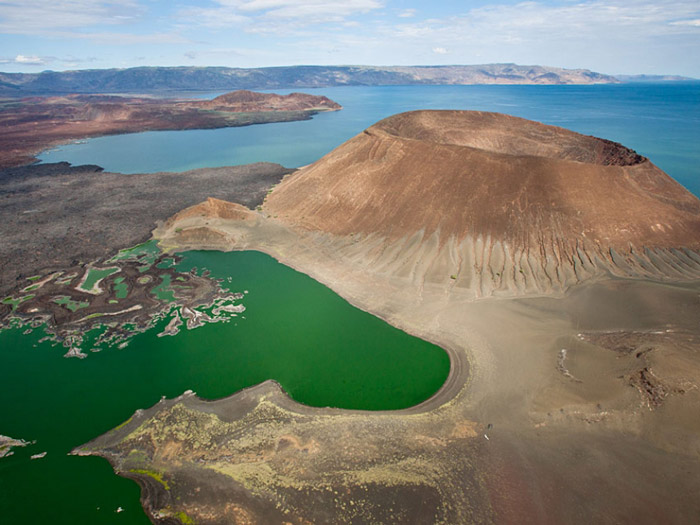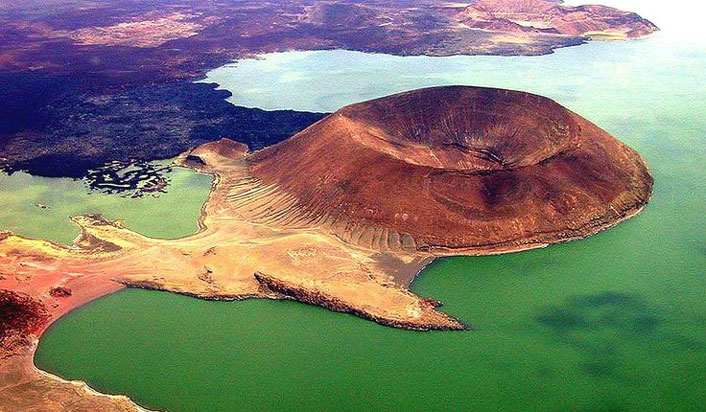Lake Turkana National Park - Kenya
Unesco's Scientific, Educational and Cultural Organization has recognized Kenya's Lake Turkana National Park as a World Natural Heritage in 1997.
Lake Turkana National Park, Kenya - World Natural Heritage
Lake Turkana National Park is a lake area in the Great Riff Valley of western Kenya. Due to the impact of volcanoes in the past, the structure of this area is extremely unique and strange. Lake Turkana is also known for being the largest and most salty lake in Africa . In fact, this national park is made up of three areas: Lake Turkana, Sibiloi Park, Central National Park with a total area of 161,485 ha and a total area including the outer ring area. 7,000,000 ha. The area of Lake Turkana is also extremely impressive, with a length of 249 km extending from the Ethiopian border; The largest point of the lake is 44 km in size and an average depth of 30 meters. This is the 4th largest lake in the African region and is often called the Jade Sea by the people in the area because of the beautiful, rare colors of the lake.

Not only impressed by the beauty and color and size, Lake Turkana also possesses sediments with thousands of year old fossil samples. Geologists think that because of volcanic activity, the geology of the reservoir area and the area around the lake is very special. The sediment deposited for thousands of years with many archaeological fossils is evidence of diverse life from prehistoric times. Besides, by studying fossils and sediments in the area where scientists can recreate the life of the flora and fauna here.
The entire area of Lake Turkana National Park is also home to hundreds of species of birds, countless species of animals and especially the home of the extremely rare Nile crocodile . In addition, the national park is also a suitable place for many plants to grow so this area has quite diverse vegetation. Ecological conditions in the garden have so far been maintained and well preserved for the development, growth and growth of flora and fauna.

In 1969, the first fossil record in Lake Turkana National Park was discovered and since then archaeologists have conducted more research, searching in the area and finding many other fossils. These fossils show evidence of the existence of a tribe two million years ago, and reflect quite clearly the daily life and evolution of the ethnic group from this prehistoric period . . The park is also the only place in the world that has the Koobi Fora ore fossils .

Since archaeologists found fossils here, the area received more attention from regional authorities. In 1997, Lake Turkana National Park was recognized as a World Natural Heritage by Unesco , and in 2001 this heritage continued to be recognized for the second time.
The landscape is extremely beautiful and impressive, but the area of Lake Turkana often faces drought, the annual rainfall here is less than 250mm. It is rare to see rain in the national park so these rare, rare rains are only enough to keep life for plants and animals. Fortunately, the life around Lake Turkana does not expect much in the rain, but 90% of the water in the lake is due to the water flowing from the Omo River and the Turkwel River. Therefore, despite the hot and dry year-round climate, Turkana National Park is a paradise for many wild animals with riverside life such as birds, hippos, and crocodiles. The national park is also an important stop on the migration path of African birds. The lives of some ethnic minorities in Kenya also depend heavily on this area.

Lake Turkana National Park is recognized as a heritage by Unesco under the criteria (viii), (x).
- The geological layer and fossil patterns in Lake Turkana National Park are testament to an important period of earth history. Besides, by studying and analyzing fossils here, scientists have gained more knowledge about human ancestors as well as the development of prehistoric people.
- Lake Turkana National Park is a diverse habitat suitable for many species of flora and fauna, is a habitat and growth place for many animals, including particularly rare species such as lions, zebras and fish. crocodile .
Not only are the animals and plants living on the ecological environment in the national park area, but many tribes around the area also depend on this lake.







- Survival war on Kenya grassland
- The most miserable tribe on the planet
- Mount Kenya National Park
- Kenya discovered huge groundwater resources
- Spectacular jumping antelope escaping crocodile jaws
- The strange lake contains millions of rainbow-colored stones
- The lake boils all year round on the island of Dominica
- The cleanest lake in the world
- Mysterious lake color change
- The stunning scenery of Plitvice National Park, Croatia
- Every summer park turns into a lake
- Admire the strange 'jellyfish' phenomenon in Canada
 Suzhou classic bonsai garden - China
Suzhou classic bonsai garden - China Chau Nguyen Dynasty
Chau Nguyen Dynasty Thai Son Mountain - World Wonder
Thai Son Mountain - World Wonder Ancient villages of Shirakawa-go and Gokayama
Ancient villages of Shirakawa-go and Gokayama